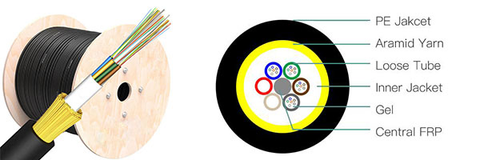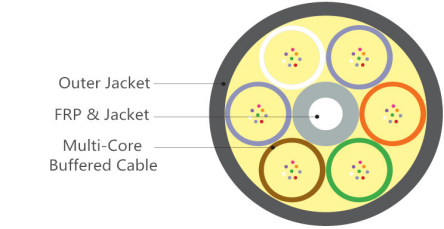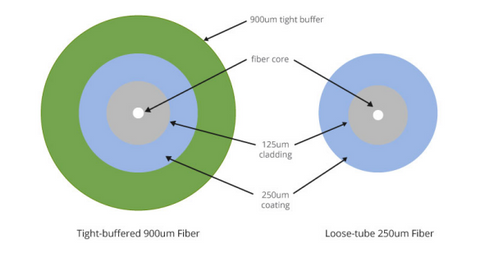Tight-buffered fiber cable and loose-tube fiber cable are two structural forms of optical cables. They are designed for different environments.
Do you feel that their structures are similar and it is difficult to tell them apart? Don't know how to choose? Let's introduce the structure of this two optical cables and how to choose and apply.
1. What is loose-tube fiber optic cable?
The loose-tube fiber cable uses 250µm fiber. Mainly used for outdoor optical cables. Because outdoor optical cables will be stressed by various environmental conditions, the optical fiber core, coating and cladding of loose-tube optical cables are enclosed in protective sleeves and are well protected.
The bundle of loose-buffered cables is filled with a waterproof gel, that protects every fiber. The waterproof gel can protect the optic fibers from moisture. In addition, the gel-filled buffer tube has the ability to expand and contract when the temperature changes.

2. What is tight-buffered fiber optic cable?
Tight-buffered fiber cable uses 900μm fibers. Mainly used for indoor optical cables, also can be used for outdoor optical cables. Unlike loose-tube cables, tight-buffered cables are not protected by waterproof gels and other sleeves. The fiber optic core is protected by two layers of coating, the first is plastic and the second is waterproof acrylic.
The acrylic coating prevents moisture from entering the cable, acting similar to a waterproof gel. But the core wire of the tight-buffered cable will not be exposed, because the acrylic coating tightly wraps the plastic fiber layer, so it will not expose the optical fiber even when it is buried in the ground or immersed in water.

3.Difference between loose-tube fiber optic cable vs. tight-buffered fiber optic cable
In order to understand the two types of optical cables more intuitively. Below we will compare them from two aspects, feature and application environment.
3.1 Different structure

The fiber of tight-buffered fiber cable has 900μm tight buffer and loose-tube fiber cable has not.
Loose-tube optical fiber cable uses waterproof gel to protect the optic fibers from moisture, and tight-buffered fiber cable uses acrylic coating to prevent moisture from entering the cable.
3.2 Different different application environments
Loose-tube cable protects the fiber from stresses caused by the environment, namely moisture and temperature. Loose-tube gel-filled cables can provide the best protection in outdoor environment, so loose-tube fiber cables are the best for outdoor use.
Loose-tube fiber cable is a good choice if cables are installed in environment with high humidity, or environment with large temperature changes. But it is not suitable for intrusion into water or where there are many bends, the pressure caused by water and bends may expose the fibers.
Loose-tube fiber cables are suitable for long-distance outdoor applications, including aerial, duct, LAN communication, CATV, computer network systems. But since it is not convenient to be spliced and terminated, it is not the first choice for indoor use.
Tight-buffered cable is sturdier than loose-tube cable. And because there is no injected gel to clear off prior to the termination process, it is convenient for construction, convenient for terminal connection, easy for classification and flame retardant. Thus tight-buffered cable is more suitable for indoor use.
Tight-buffered fiber cable is suitable when buried or underwater applications are required. And it has the advantages of easier termination and splicing, which makes tight-buffered cables satisfy the diverse requirements existing in high performance fiber optic applications, such as medium distance transmission for telco local loop, LANs, WANs, SANs and point-to-point links in cities, buildings, factories, campuses and office parks.
3.3 Different features and advantages
Comparison of features and advantages of loose-tube and tight-buffered cables
|
Loose-tube Fiber Optic cable |
Tight-buffered Fiber Optic Cable |
|
|
Fiber size |
250µm fiber |
900µm fiber |
|
Main use |
outdoor |
indoor |
|
Waterproof material used |
waterproof gel |
acrylic coating |
|
Place with many bends |
not suitable |
suitable |
|
Underwater application |
not suitable |
suitable |
|
Better place than the other |
higher density |
higher flexibility |
|
better temperature properties |
higher tensile strength |
|
|
smaller size |
easier termination and splicing |
Due to the difference of the 900μm fiber and the 250μm fiber, tight-buffered cable holds less fibers versus loose-tube cables using a similar diameter and it is much more expensive than loose-tube cables.
Tight-buffered cable and loose-tube gel-filled cable both have color coded fibers for easy identification when used as distribution cables.
4. Conclusion
Tight-buffered cable and loose-tube cable are both excellent rugged fiber optic cables. Choose them according to the application environment that going to use. The loose-tube cable is for long-distance outdoor applications, while the tight-buffered cable is usually used for moderate length indoor applications
you may like: What is the Bandwidth of Fiber Optic Cable

